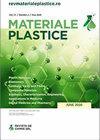The Use of Products of Microwave Aminolytic Destruction of Polyethylene Terephthalate in Vibration-absorbing Polymer Composite Materials
IF 0.7
4区 材料科学
Q4 MATERIALS SCIENCE, MULTIDISCIPLINARY
引用次数: 0
Abstract
The aim of this work is to study the possibility of using the products of aminolytic destruction of polyethylene terephthalate (PET) and their derivatives in polymer composite materials with vibration-absorbing properties, which provide effective damping of vibrations of technogenic and natural origin in a wide temperature and frequency range. The paper considers a modern method of recycling PET waste with a mixture of amino alcohols - monoethanolamine and triethanolamine, taken in two different ratios. As a result of the destruction reaction, terephthalic acid diamide (N, N -bis (2-hydroxyethyl) terephthalamide) is formed. To accelerate the destruction process, microwave radiation of various powers of 200, 540 and 700 watts was used. The optimal conditions for aminolytic decomposition of PET were determined: the time and power of microwave radiation with PET conversion up to 95% and the yield of the target product (terephthalic acid diamide) 80-85%. The destruction process was carried out according to a closed cycle of using reagents, without the use of catalysts and at atmospheric pressure, which to a certain extent reduces the energy consumption and increases the environmental friendliness of this method of PET decomposition. The aminolytic degradation product of PET (terephthalic acid diamide) was used as a monomer in the polycondensation reaction to obtain a new oligomer (terephthalic acid oligoesteramide). The degree of polymerisation (n) is in this case 7 to 11 (number of chain links). The obtained oligomer and the PET degradation product were investigated as new components in elastomeric compositions based on chloroprene rubber and in compositions based on thermoplastic elastomers. It has been demonstrated that the introduction of an oligomer based on a PET degradation product reduces the viscosity of elastomeric compositions by 25-35%. The study was supported by a grant from the Russian Science Foundation No. 21-79-00301, https://rscf.ru/project/21-79-00301/.微波氨基降解聚对苯二甲酸乙二醇酯产物在吸振聚合物复合材料中的应用
本工作的目的是研究将聚对苯二甲酸乙二醇酯(PET)及其衍生物的氨基分解破坏产物用于具有吸振性能的聚合物复合材料的可能性,该材料在宽温度和频率范围内有效阻尼技术和自然来源的振动。本文考虑了一种用氨基醇——单乙醇胺和三乙醇胺的混合物,以两种不同的比例回收PET废物的现代方法。作为破坏反应的结果,形成对苯二甲酸二酰胺(N,N-双(2-羟乙基)对苯二甲酰胺)。为了加速销毁过程,使用了功率分别为200、540和700瓦的微波辐射。确定了PET氨解分解的最佳条件:微波辐射时间和功率,PET转化率可达95%,目标产物对苯二甲酸二胺的产率为80-85%。破坏过程按照使用试剂的封闭循环进行,不使用催化剂,在大气压下进行,这在一定程度上降低了能量消耗,提高了PET分解方法的环境友好性。在缩聚反应中使用PET的氨基水解降解产物(对苯二甲酸二酰胺)作为单体,以获得新的低聚物(对苯二甲酸低聚酰胺)。聚合度(n)在这种情况下是7-11(链节的数量)。研究了所获得的低聚物和PET降解产物作为基于氯丁二烯橡胶的弹性体组合物和基于热塑性弹性体的组合物中的新组分。已经证明,引入基于PET降解产物的低聚物将弹性体组合物的粘度降低25-35%。该研究得到了俄罗斯科学基金会21-79-00301号的资助,https://rscf.ru/project/21-79-00301/.
本文章由计算机程序翻译,如有差异,请以英文原文为准。
求助全文
约1分钟内获得全文
求助全文
来源期刊

Materiale Plastice
MATERIALS SCIENCE, MULTIDISCIPLINARY-
CiteScore
1.40
自引率
25.00%
发文量
99
审稿时长
6-12 weeks
期刊介绍:
Materiale Plastice, abbreviated as Mater. Plast., publishes original scientific papers or guest reviews on topics of great interest.
The Journal does not publish memos, technical reports or non-original papers (that are a compiling of literature data) or papers that have been already published in other national or foreign Journal.
 求助内容:
求助内容: 应助结果提醒方式:
应助结果提醒方式:


